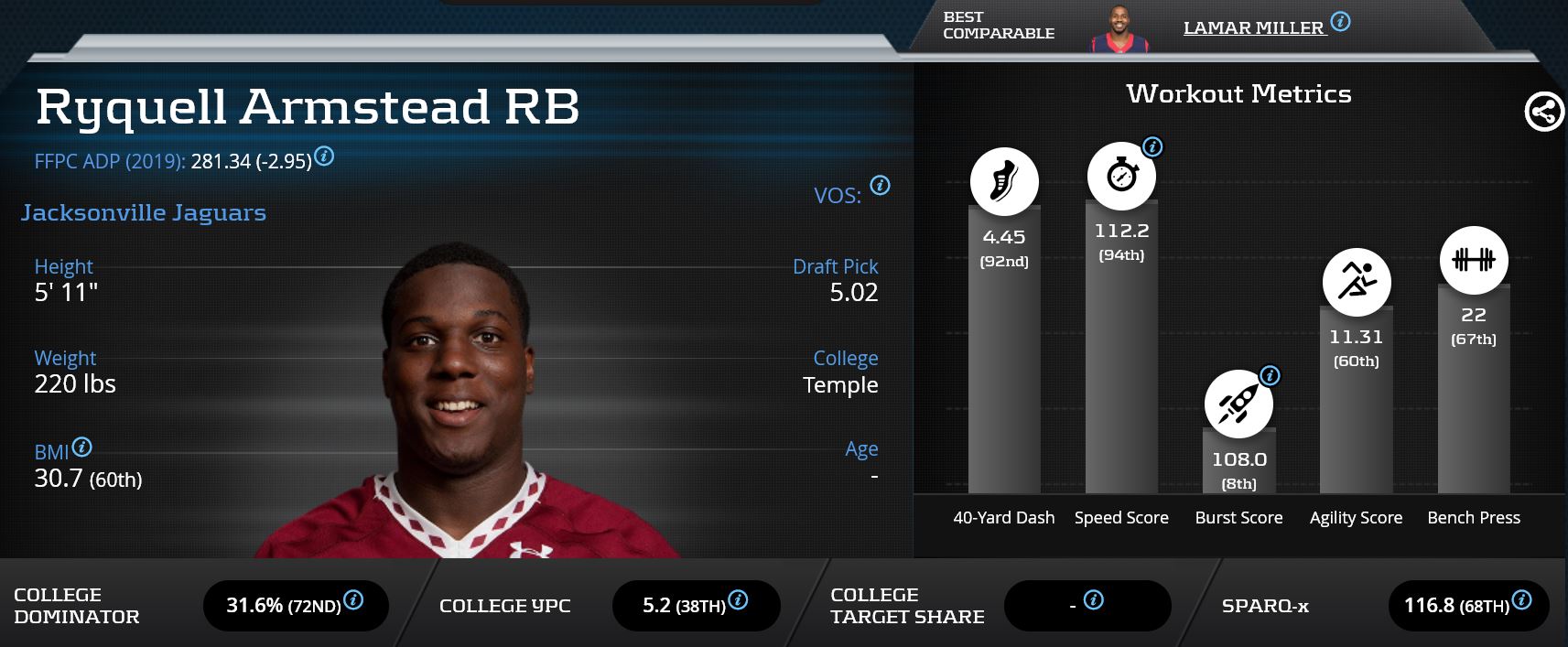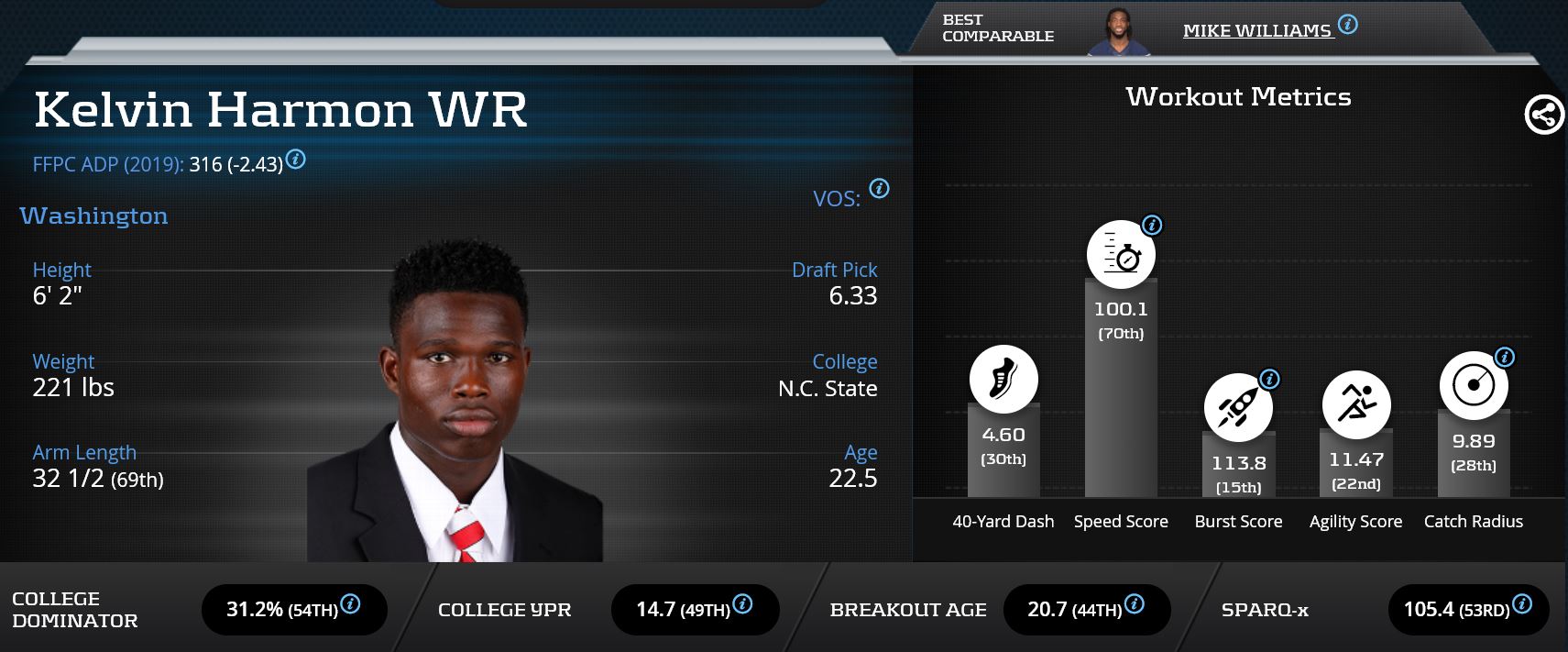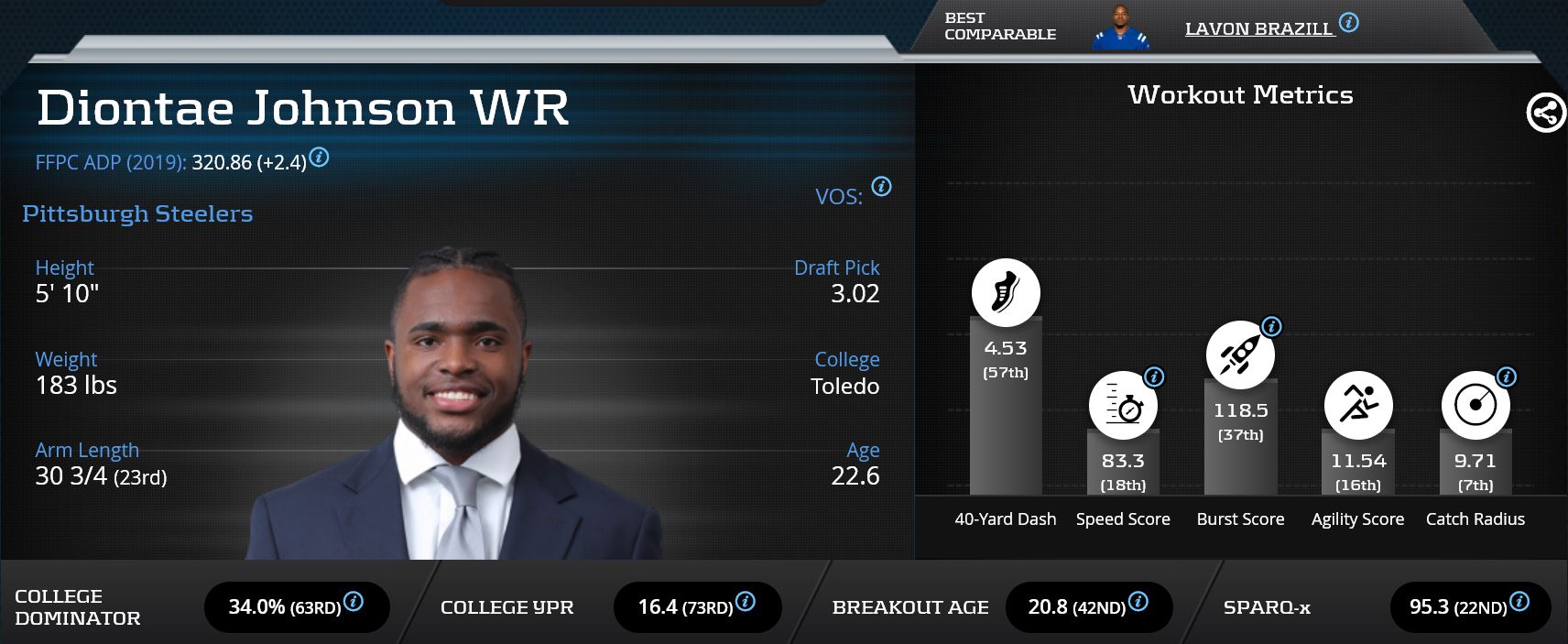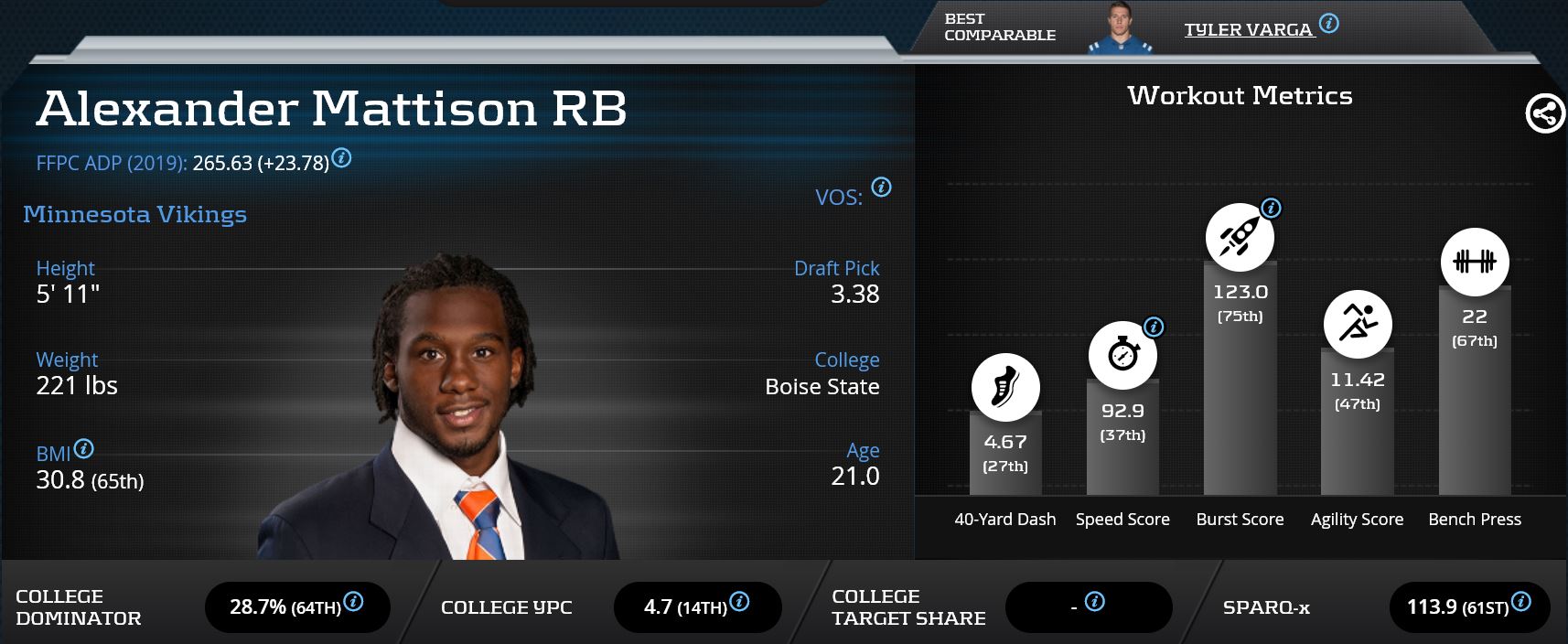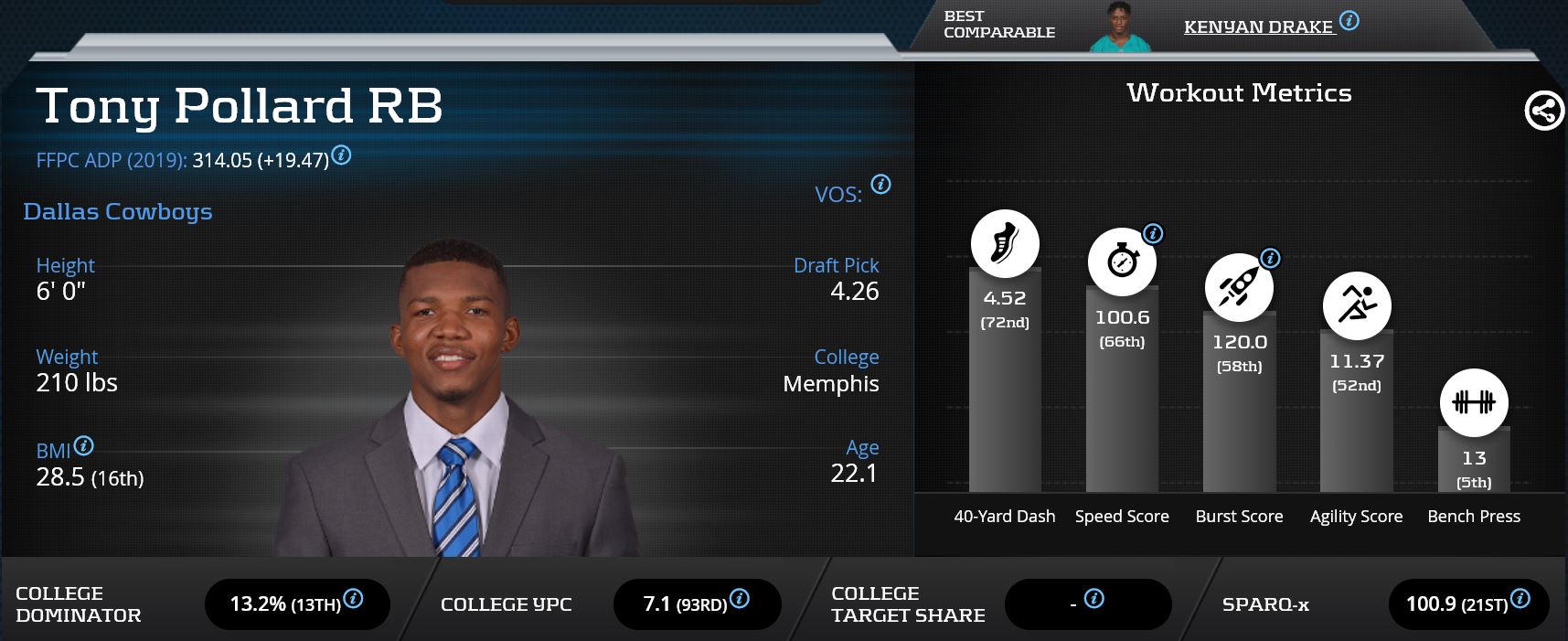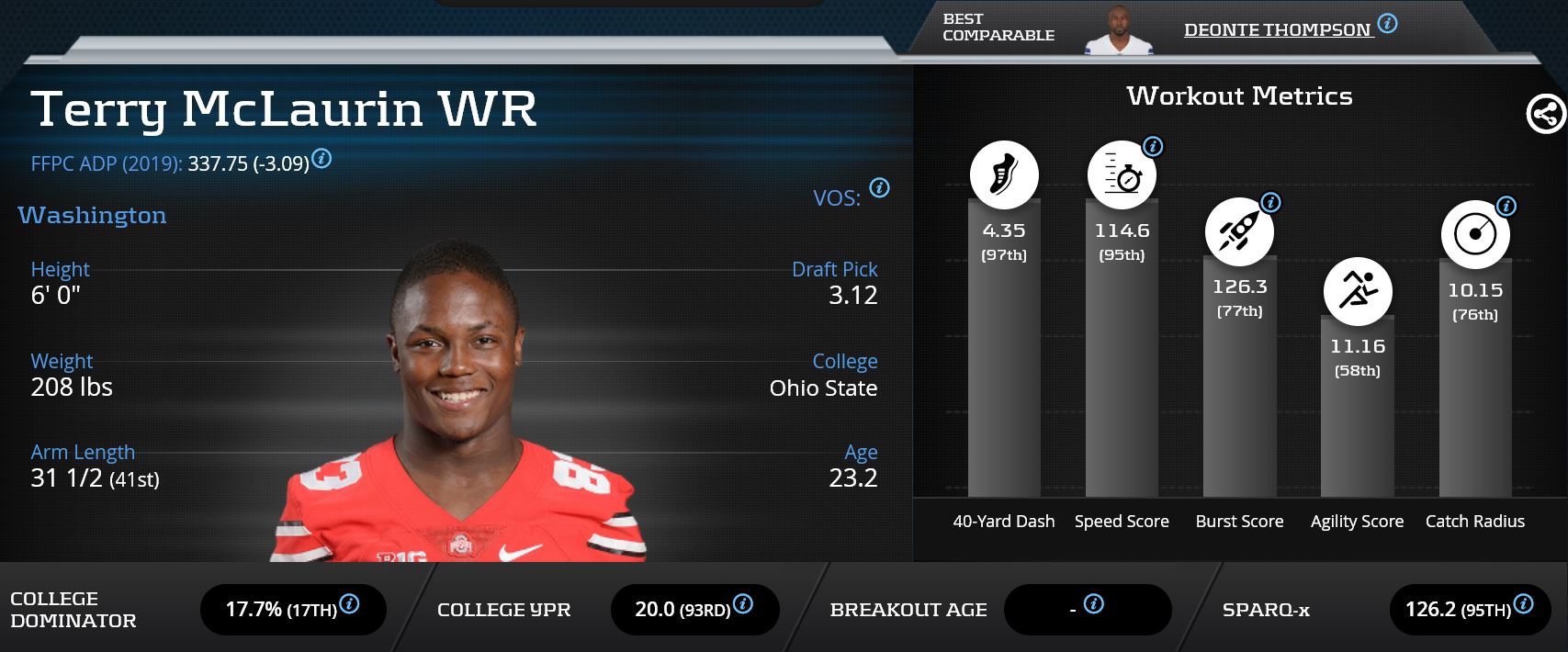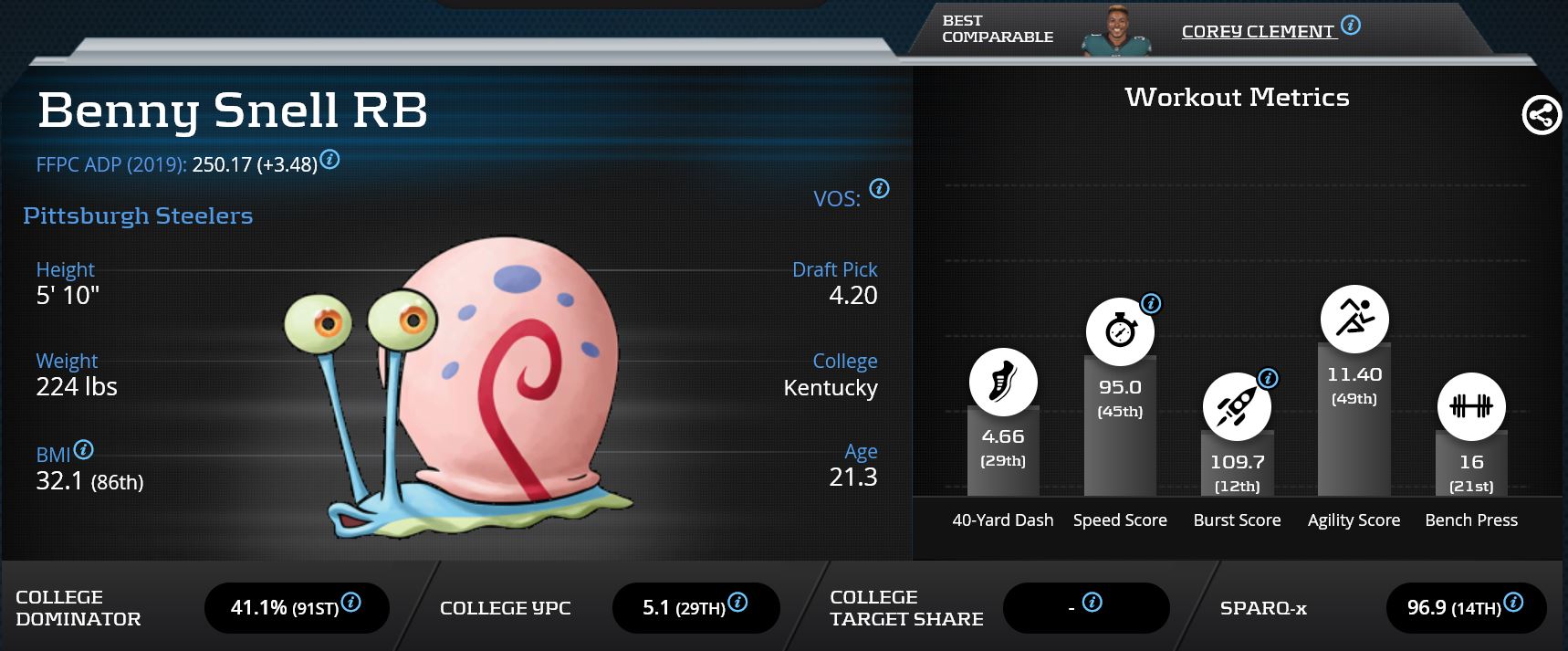Round Three of the 12-team, four round rookie mock draft conducted at RotoUnderworld is where business began to pick up. Two quarterbacks were taken off the board, and the No. 6 pick in the NFL draft wasn’t one of them. Three wide receivers and seven running backs comprised the rest of the third round field. Oddly enough, zero tight ends leaked into the third frame despite the depth of the rookie class. Loyal readers will have to wait until Round Four for all of the pertinent late round rookie TE analysis.
In examining the advanced stats, metrics and analytics profiles of players the way that we do here, we’ve tended to be higher and lower on certain players than consensus over the years. As such, it may surprise you to see where some of them were picked in this experiment. Especially as we delve deeper into these last two rounds, where the variance had no choice but to increase. This four-part series, featuring 12 minions and/or friends of the Underworld, will tell you everything you need to know to help you slay your rookie drafts.
3.01 – Dwayne Haskins, QB, Washington
Analyst: Anthony Cervino (@therealnflguru)
Rationale: While there was still some upside talent on the board at other positions, I didn’t mind taking a shot on Dwayne Haskins at the 3.01 spot. Being the top incoming quarterback target for Redskins hands-on owner Daniel Snyder as well as general manager Bruce Allen means he is the future at the position. Because he was the 15th overall pick in April’s draft, we could see the Ohio State alum under center sooner rather than later. In fact, reports are suggesting that Haskins and free agent acquisition Case Keenum will be competing for the Week 1 QB1 job. If Haskins is the real deal, he’ll win the job because you know, Case Keenum and all. However, even if Keenum opens the year on top of the depth chart, I fully expect Haskins to start more games. Now, I’m not expecting to have to play Haskins this year in fantasy. But if he looks the part, I can either flip him or the ghost veteran signal caller on my dynasty squad to improve my team elsewhere in-season. Especially if a league mate has an infatuation for Haskins and will overpay. Everyone is looking for the next Deshaun Watson or Baker Mayfield and will over-draft and/or overpay for it. Just look at their early-single-digit round ADPs. Haskins won’t give you much on the ground, which kills his rushing floor. He ran a sluggish 5.04 40-yard-dash, and produced a meager 194 rushing yards and four touchdowns on 103 attempts in 22 collegiate appearances. He earned the 2018 Big 10 Offensive Player of the Year award while finishing third in the Heisman Trophy voting behind Kyler Murray and Tua Tagovailoa as a pure pocket passer. He completed 413-of-590 passes (70-percent) for 5,396 yards and a 54:9 touchdown-to-interception ratio in his career, compiling a 13-1 win/ loss record in 2018. Haskins is your prototypical pocket quarterback with highly-touted toughness and a willingness to take chances with his big arm. While his lack of mobility could hinder his growth in Jay Gruden’s system early on, his size, strength, and intelligence should be able to make up for his mobile shortcomings further along in the process.
Other Considerations: Diontae Johnson, Bryce Love, Terry McLaurin.
Beats by Ray: Washington team owner Daniel Snyder sat in on only one interview during the 2019 NFL Combine. This player, Dwayne Haskins, also happened to go to the same high school as Snyder’s son. Despite late-breaking rumors of the team’s interest in Daniel Jones, this pick was set in stone. Especially once it was known that Snyder would be taking over the first round of his team’s draft. He’s already well on track to be named the Week 1 starting quarterback. All he has to do is show a glimmer of life in the preseason.
Some will focus on factors like Dwayne Haskins‘ lower-percentile Breakout Age and lack of long speed. The focus should be on factors like the upper-percentile College QBR and College YPA. Factors like passing for 4,800-plus yards and 50 touchdowns in his first and only season as Ohio State’s starting quarterback. A season where he ranked second in the nation in pass attempts. A Heisman trophy finalist and Rose Bowl MVP, he’s best comparable on Player Profiler to Ben Roethlisberger and Jameis Winston. Players with starting roles will be harder to come by at this point in rookie drafts. He’s well worth this selection, even in single-QB formats.
3.02 – Rodney Anderson, RB, Bengals
Analyst: Ray Marzarella (@rayraymarz)
Rationale: If making this selection 10 times, I’d be talking myself into picking Bryce Love half of the time. This was one one of those occasions where I talked myself into Rodney Anderson. Both players are recovering from torn ACL’s suffered last season. But Love’s injury happened in Stanford’s regular season finale, while Anderson’s occurred in Oklahoma’s second regular-season game. Neither are locks to be healthy enough to make early-career impacts for their teams. Anderson, though, is more likely to step into a feature back role in the event of injuries to teammates. Even if that isn’t ready to happen until 2020. With no recorded workout metrics, he’s a black box athlete. And his lengthy injury history is a glaring red flag. But in his one healthy college campaign, the all-important second season with playing time, he offered a glimpse into his pro potential. He rushed for 1,161 yards and 13 touchdowns while splitting time with Trey Sermon. He crushed Sermon as a pass-catcher, besting him in receptions (17 to 16), yards (281 to 139) and touchdowns (5 to 2). With Trayveon Williams presumably drafted to replace Giovani Bernard next season, Anderson projects more as a direct backup to Joe Mixon. But we can’t forget that Mixon has a troubled history. That alone makes this pick at the 3.02 slot 100-percent worth the upside.
Other Considerations: Bryce Love, Ty Johnson, Kelvin Harmon.
https://www.youtube.com/watch?v=KAsnnBQ5pNo
Beats by Ray: (“uh-huh-huh. Hey Beavis, he said butt love. uh-huh-huh”)
3.03 – Bryce Love, RB, Washington
Analyst: The Podfather (@Fantasy_Mansion)
Rationale: Bryce Love is a year away, which is why I would prefer to select Dexter Williams here, but this is a RotoUnderworld rookie draft where the participants usually focus on the right details. If you can’t draft an efficient, athletic college back with feature size like Williams, Bryce Love is the next-best choice. Love would have been a fringe first round rookie pick had he entered the NFL Draft after rushing for 2,118 yards in 2017, but he stayed in school, struggled on the field, and was finally carted off with a torn ACL to close out a miserable 2018 campaign. Brutal. These brutal events create value in fantasy football, and Love is the ideal taxi squad stash. Once healthy, Love will be the lightening to Derrius Guice‘s thunder in Washington.
Other Considerations: Ryquell Armstead.
https://www.youtube.com/watch?v=UEKZRQKcRWU
Beats by Ray: There’s nothing wrong with selecting a former 2,000-yard rusher in the third round of a rookie draft. Bryce Love may be a year away. But the path to playing time in 2020 is easier than that of a player like Rodney Anderson. He just needs Chris Thompson to leave in free agency next year so he can slide into the satellite back role. His receiving usage fluctuated over his time at Stanford. Though he did manage a 15-catch freshman season with Christian McCaffrey, who caught 45 balls that year, on the roster. Though undersized, he has satellite back-plus potential at the next level.
3.04 – Ryquell Armstead, RB, Jaguars
Analyst: Ed DeLauter (@FF_Litigator)
Rationale: I was very interested in seeing where Ryquell Armstead would go on draft day due to his college production and combine metrics. If any sort of draft capital was there for him, I was going to be interested. He wound up going to the Jaguars on Day Three, and I love this landing spot for him. Alfred Blue is the only real competition for snaps as Leonard Fournette‘s backup. So Armstead should see opportunity in his rookie season when Fournette either wears out his welcome with the Jaguars brass or injures himself again. Fournette has never played a full season in the NFL, so Armstead is going to see the field if secures backup duties. When he does, I would definitely bet on him not going away if/when Fournette either gets healthy or gets out of the doghouse. Armstead’s 4.45 40 yard dash time at 220-pounds gives him a size-speed freakiness that should translate to NFL success. At this point in the draft, I’ll take a chance that it does and that he seems some opportunity in year one.
Other Considerations: Diontae Johnson, Kahale Warring.
Beats by Ray: Ryquell Armstead is big, fast and athletic. Which automatically makes him a winner in this draft class regardless of landing spot. Unlike Leonard Fournette, he comes to Jacksonville without a history of off-field issues and lower body ailments. This increases his chances of seeing rookie year playing time and being able to return value at this draft slot. His poor burst and limited pass-catching chops could be a problem if the offense underperforms. But these worries are already baked into his draft slot in both rookie and seasonal league drafts.
3.05 – Kelvin Harmon, WR, Washington
Analyst: Mark Leipold (@LeipoldNFL)
Rationale: While Kelvin Harmon does not possess the draft capital that many analysts anticipated, his landing spot gives him plenty of opportunity for early production. Washington’s wide receiver depth chart is thin at best and he’ll be tied to Dwayne Haskins for the foreseeable future, which is a good thing in my mind. His size and body control may be enough to overcome his subpar athleticism marks. Film grinders touted Harmon as having some of the best hands in the class, so there are still a number of reasons that Harmon could turn into a solid producer on a potentially ascending offense.
Other Considerations: Jace Sternberger or trade back.
Beats by Ray: Kelvin Harmon marks the third Washington player selected in the first five picks of Round Three. As we’ve talked about previously, college production typically matters a lot more for wide receiver prospects than athleticism. The Breakout Age may be below average, but he broke out during his all-important second season with playing time. What a player can achieve after having a year to acclimate to the collegiate game on the field can give us a glimpse into their professional ceiling. Harmon was considered by some to be a first-round prospect before flaming out at the combine. We’ve seen this story play out before with Keenan Allen, who fell to the third round of the 2013 NFL Draft. Competing primarily with perennial underachiever Josh Doctson for targets, Harmon could be a huge steal as a sixth-rounder.
3.06 – Diontae Johnson, WR, Steelers
Analyst: Jesse de Luca (@JesseDeLucaFB)
Rationale: Taken with the second pick of the third round, Diontae Johnson profiles as an immediate special teams producer who could also see himself in a starting receiver role. Viewed as a player who can play on the outside or in the slot, the Steelers opted for his versatility over players such as Jalen Hurd and Miles Boykin. Johnson is no slam dunk prospect, but could become productive as a rookie with a starting role in a prolific offence.
Other Considerations: Will Grier.
Beats by Ray: Before the draft, Diontae Johnson was not ranked inside the Top 50 in Player Profilers’s rookie receiver rankings. Being selected by a team like the Steelers with and early third round pick automatically puts him on the radar. He’s been called the best punt returner in this rookie class. And we’ve learned over the years that plus-level return ability can be a predictor of NFL success. A lot of parallels have been made between Johnson and former Steelers special teams ace turned elite receiver Antonio Brown in that regard. The issue is that Brown at least displayed above-average agility, while Johnson’s Agility Score is bad. His second college season was his most productive, and he performed well in the face of bad quarterback play. But there are enough question marks on his profile to justify his fall to the third round here. Even if he was picked by a good offensive team with a high pick.
3.07 – Will Grier, QB, Panthers
Analyst: Mike Randle (@RandleRant)
Rationale: Let’s think this through. Will Grier had the highest throw velocity at the NFL Combine, had a 9.7 (92nd-percentile) yards per attempt in college and lands on a team with a 30-year-old injury prone quarterback. Throw in the bevy of offensive weapons in Carolina with D.J. Moore, Curtis Samuel, Christian McCaffrey, and Greg Olsen, and you have a third-round rookie pick that is one injury away from fantasy relevance. While his advanced age scares some away, Grier has a chance to be the best quarterback in this draft class. That’s an autopick in round three.
Other Considerations: Alexander Mattison.
https://www.youtube.com/watch?v=5laceNNWriA
Beats by Ray: Will Grier excelled at West Virginia as the leader of Mike Leach disciple Dana Holgorsen’s Air Raid spread attack. Granted he wasn’t drafted to Carolina to be the starter, and they don’t run an offense like Grier ran in college. But that doesn’t mean he can’t be successful if he gets the chance to start some games for Cam Newton. He offers plus-mobility and standout accuracy. Those who knock his arm strength may have missed him clocking a class-best 59-MPH ball velocity on the Combine radar gun. An elite supporting cast can help smooth out his transition to the pros. And if Arizona can make the Air Raid catch on, we could eventually see a QB-needy team trade for a player with experience running that system in Grier.
3.08 – Darwin Thompson, RB, Chiefs
Analyst: Akash Bhatia (@FantasyKash)
Rationale: Darwin Thompson is a great third-round pick who can improve his value in year one. Damien Williams was the third string back a year ago, and bruiser Carlos Hyde is on his fourth team in two years. On one of the leagues most prolific offenses, all Thompson needs is a chance.
Other Considerations: None.
Beats by Ray: After playing at Northeastern Oklahoma A&M (which we promise is a real school) for two years, Darwin Thompson arrived at Utah State. He rushed for over 1,000 yards, scored 16 total touchdowns and caught 23 passes in his one season there. He could’ve stayed in school for one more year and entered the loaded 2020 running back class. But he smartly chose to enter this year’s draft instead, and landed in a great spot. Some around these parts think James Williams, who the Chiefs signed after the draft, is a better player. But Williams has already been cut by the team. As much as we love Damien Williams, he’s never had more than 50 carries in any season as a pro. And it shouldn’t take much to pass Carlos Hyde on the depth chart. He’s the viable replacement for Charcandrick West, and a good pick in this spot.
3.09 – Alexander Mattison, RB, Vikings
Analyst: Clint Hale (@DeviantDynasty)
Rationale: Drafted with a late third round supplemental pick by the Vikings, Alexander Mattison immediately becomes the one-for-one backup to the injury-plagued Dalvin Cook. Mattison displayed explosion at the NFL combine with a 123.0 (75th-percentile) Burst Score and is still just twenty years old. Although he profiles as a grinder at 5-feet 11-inches and 221-pounds, he did catch 28 and 27 balls in his sophomore and junior seasons, respectively. With a sweet landing spot in Minnesota’s offense, Mattison could be a fantasy week-winner in any games Cook misses.
Other Considerations: None.
Beats by Ray: Alexander Mattison is a polarizing prospect. Some think he’s just another Boise State compiler at the running back position. Others think he’s shown enough to enter his rookie year as Dalvin Cook‘s direct backup. The answer likely lies somewhere in the middle. On the plus side of the ledger, he displayed a decent all-around skill set with two 20-plus reception seasons. He also has a great Burst Score with a a well-below-average college YPC, lending credence to the compiler argument. This could help explain why only nine of his 302 carries last season gained 15 yards or more. He still has enough functional athleticism, and high enough draft capital, to work his way into a role as Cook’s direct backup.
3.10 – Tony Pollard, RB, Cowboys
Analyst: Alex Johnson (@a_johnsonff)
Rationale: Tony Pollard ran behind the historically efficient Darrell Henderson at Memphis, where he himself averaged over seven yards per carry over his final two seasons. He now will compete for the backup job behind Ezekiel Elliott.
Other Considerations: Kahale Warring.
Beats by Ray: In an alternate universe where Saquon Barkley stays at Penn State for one more season, Tony Pollard is this year’s Miles Sanders. As it stands, Pollard was still drafted in the fourth round despite being stuck behind Darrell Henderson on the Memphis depth chart. That didn’t stop him from scoring 25 touchdowns in three years. Nine were rushing scores, nine were receiving scores and the additional seven came via kick return. Though his measured agility isn’t elite, the fact that he knows how to traverse the football field and score touchdowns is undeniable. If something happens to Ezekiel Elliott, Pollard will be a player to blow your FAAB budget or a priority waiver claim on.
3.11 – Terry McLaurin, WR, Washington
Analyst: Neil Dutton (@ndutton13)
Rationale: Washington is a not a team that, at first glance, is going to overflow with fantasy goodness in 2019. I hope I’m shattering no illusions with this revelation. However, someone has to catch passes…I believe. Terry McLaurin probably won’t catch a lot of them, but if he does, he profiles as someone who will be catching them a long way down the field. A 93rd-percentile college YPR can certainly attest to this, as can his 97th-percentile 40-yard dash time. Pickings were pretty slim at this stage of the draft, to be perfectly honest.
Other Considerations: Kahale Warring.
Beats by Ray: On the opposite side of the Kelvin Harmon spectrum lies Terry McLaurin. A player whose elite size-adjusted athleticism got him drafted in the third round despite minimal college production. We excuse Parris Campbell‘s relative lack of college dominance because of the role he was asked to play at a school with elite target competition. By the same token, we should give McLaurin a little bit more benefit of the doubt. Especially given the narrative of having been Dwayne Haskin’s teammate last season. The problem is that despite scoring 11 touchdowns in 2018, McLaurin didn’t have a high enough College Dominator Rating to qualify for the Breakout Age metric. But it’s hard to ignore 4.35 speed at 6-0 and 208-pounds. And though I qualify for truther status on Paul Richardson, his injury history is scary. McLaurin may be more of a best ball asset early on in his career. But the depth chart may not be hard to climb.
3.12 – Benny Snell, RB, Steelers
Analyst: Sean McClure (@spmcclure89)
Rationale: This is simply a play on opportunity. Pittsburgh has consistently produced weekly RB1 finishers from Le’Veon Bell to James Conner to Jaylen Samuels to past-his-prime DeAngelo Williams. If Benny Snell finds his way into a starting or even complementary role, his value could skyrocket regardless of talent level. At the very least, Snell was a productive grinder in college. There is no reason he couldn’t do the same with the Steelers if given a chance.
Other Considerations: Kahale Warring, Jace Sternberger, Josh Oliver.
Beats by Ray: Every running back picked in the third round of this mock likely needs an injury to a teammate or two to be fantasy-relevant in Year One. It’s a big part of the reason they’re all available here, which seems appropriate. Benny Snell, despite his elite college dominance, is no exception. Reports of the Steelers being more of a committee backfield are already being written off as lip service. But it can’t be completely discounted given the drafting of Snell, the presence of Jaylen Samuels and the injuries James Conner suffered in a workhorse role last year. Though his Player Profiler avitar is a cartoon snail named Gary, Snell looks like a quintessential Steelers pick. He’s another running back who flunked the Combine and was bailed out by his landing spot.


